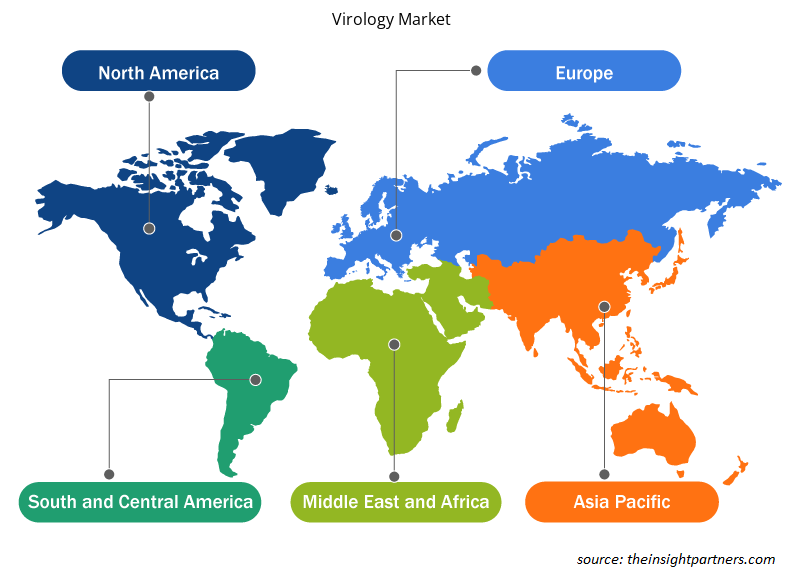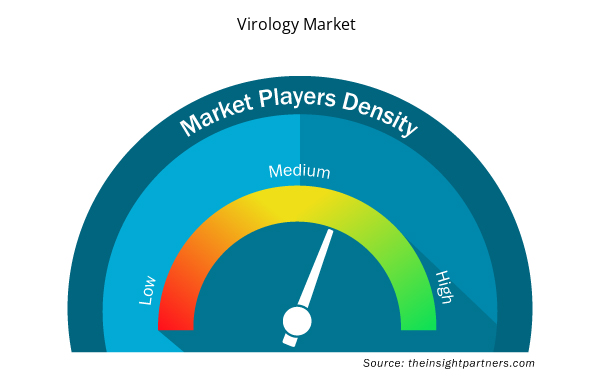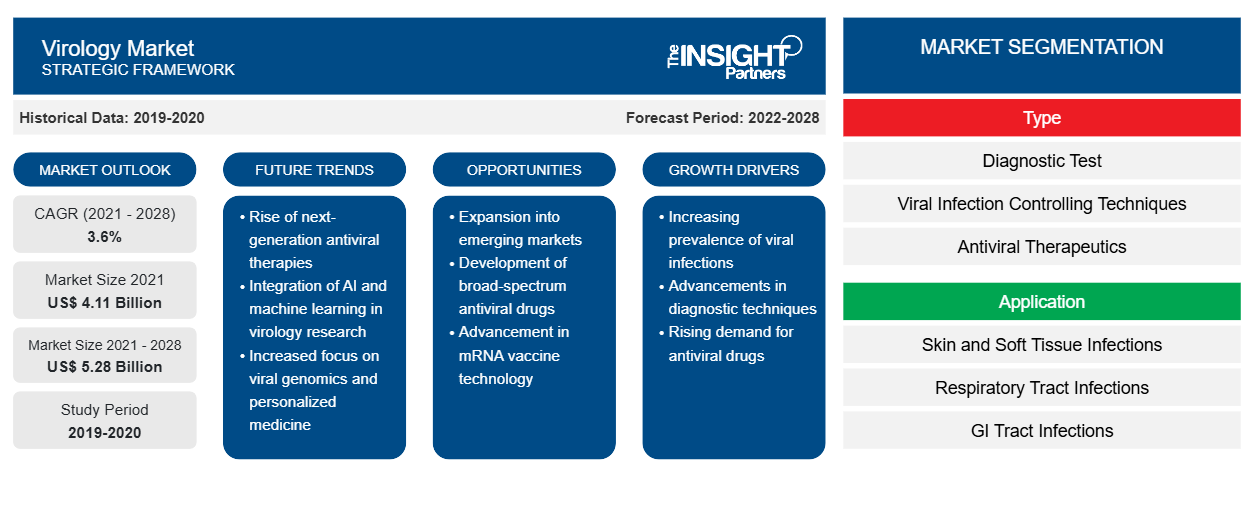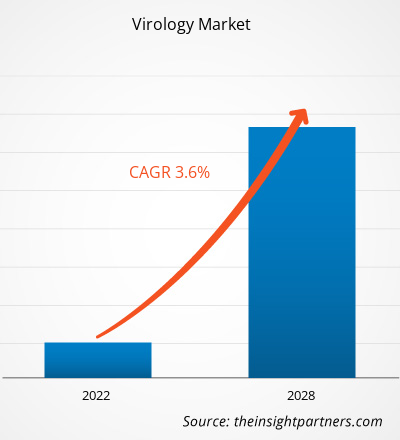Si prevede che il mercato della virologia raggiungerà i 5.276,48 milioni di dollari entro il 2028, rispetto ai 4.108,27 milioni di dollari del 2021; si prevede che registrerà un CAGR del 3,6% dal 2021 al 2028.
La virologia è tra le sezioni significative del sistema sanitario. Ha un'ampia applicazione nello sviluppo di vaccini, diagnosi, terapie di trattamento e altro. Gli operatori del mercato della virologia sono costantemente coinvolti in innovazioni e sviluppi di prodotto per sostenere la concorrenza nel mercato. Esplorano vari ambiti per le innovazioni di prodotto. Ad esempio, per COVID-19, gli operatori del mercato stanno investendo in modo significativo nello sviluppo di vaccini, kit di test e altri prodotti e servizi correlati. Di seguito sono riportati alcuni degli sviluppi di mercato correlati al mercato della virologia.
- Ad agosto 2021, la Food and Drug Administration (FDA) statunitense ha approvato il primo vaccino COVID-19 noto come Pfizer-BioNTech COVID-19 Vaccine. Sarà commercializzato come ComiRNAty (Koe-mir'-na-tee). Il vaccino è destinato a prevenire la malattia COVID-19 negli individui di età pari o superiore a 16 anni. È disponibile anche con autorizzazione all'uso di emergenza ( EUA ).
- Nell'aprile 2021, CerTest Biotec ha lanciato il suo test diagnostico COVID-19 con marchio CE per il sistema BD MAX.
- Nel maggio 2020, Bio-Rad ha ricevuto l'autorizzazione all'uso di emergenza dalla FDA per il test sugli anticorpi totali del COVID-19.
- Nel maggio 2020, Aalto Bio Reagents ha lanciato le nuove proteine Spike S1-S2 eucariotiche ricombinanti del SARS-CoV-2.
Pertanto, la partecipazione attiva degli attori del mercato attraverso innovazioni di prodotto e il sostegno dei governi di diversi paesi rafforza la crescita del mercato della virologia.
Personalizza questo report in base alle tue esigenze
Riceverai la personalizzazione gratuita di qualsiasi report, comprese parti di questo report, o analisi a livello nazionale, pacchetto dati Excel, oltre a usufruire di grandi offerte e sconti per start-up e università
- Scopri le principali tendenze di mercato in questo rapporto.Questo campione GRATUITO includerà analisi di dati che spaziano dalle tendenze di mercato alle stime e alle previsioni.
Approfondimenti di mercatoLa crescente adozione di procedure estetiche minimamente invasive e non invasive guida la crescita del mercato della virologia
Virus come il virus dell'immunodeficienza umana (HIV), il virus dell'influenza, il virus Zika , il virus Ebola, il SARS-CoV-2 e il poliovirus infettano una vasta popolazione in tutto il mondo. Poiché il virus muta ed evolve continuamente, la resistenza ai farmaci diventa una sfida importante nella gestione delle infezioni virali tra gli esseri umani e gli animali. Un virus si trasmette attraverso vari mezzi in base al suo tipo. Ad esempio, alcuni virus causano malattie virali respiratorie, come l'influenza, il raffreddore comune e l'infezione da virus respiratorio sinciziale , e vengono trasmessi tramite goccioline generate da tosse o starnuti, mentre alcune malattie virali gastrointestinali vengono trasmesse tramite contatto diretto con le feci di persone infette o tramite cibo o acqua contaminati. Secondo le statistiche globali sull'HIV e l'AIDS dell'UNAIDS , nel 2020 più di 37,7 milioni di persone in tutto il mondo sono state infettate dall'HIV.
L'International Committee on Taxonomy of Viruses ( ICTV ) ha dichiarato il nuovo coronavirus che ha causato il COVID-19 come Sindrome respiratoria acuta grave Coronavirus 2 (SARS-CoV-2) a febbraio 2020. Il virus ha subito mutazioni un paio di volte dalla sua epidemia, il che ha aumentato la gravità della pandemia di COVID-19. Ad esempio, secondo i dati del tracker COVID-19 dei Centers for Disease Control and Prevention (CDC), ad agosto 2021, il tasso di casi a sette giorni ogni 100.000 è di 299,4 e negli Stati Uniti sono stati segnalati oltre 164.952 nuovi casi . Inoltre, secondo il Centro europeo per la prevenzione e il controllo delle malattie, ad agosto 2021, il numero totale di casi di COVID-19 ha raggiunto circa 36.307.572 pazienti nello Spazio economico europeo ( SEE ). Pertanto, tale crescente prevalenza di infezioni virali sta guidando la crescita del mercato della virologia.
Approfondimenti regionali sul mercato della virologia
Le tendenze regionali e i fattori che influenzano il mercato della virologia durante il periodo di previsione sono stati ampiamente spiegati dagli analisti di Insight Partners. Questa sezione discute anche i segmenti e la geografia del mercato della virologia in Nord America, Europa, Asia Pacifico, Medio Oriente e Africa e Sud e Centro America.

- Ottieni i dati specifici regionali per il mercato della virologia
Ambito del rapporto di mercato sulla virologia
| Attributo del report | Dettagli |
|---|---|
| Dimensioni del mercato nel 2021 | 4,11 miliardi di dollari USA |
| Dimensioni del mercato entro il 2028 | 5,28 miliardi di dollari USA |
| CAGR globale (2021 - 2028) | 3,6% |
| Dati storici | 2019-2020 |
| Periodo di previsione | 2022-2028 |
| Segmenti coperti | Per tipo
|
| Regioni e Paesi coperti | America del Nord
|
| Leader di mercato e profili aziendali chiave |
|
Densità degli attori del mercato: comprendere il suo impatto sulle dinamiche aziendali
Il mercato del mercato della virologia sta crescendo rapidamente, spinto dalla crescente domanda degli utenti finali dovuta a fattori quali l'evoluzione delle preferenze dei consumatori, i progressi tecnologici e una maggiore consapevolezza dei benefici del prodotto. Con l'aumento della domanda, le aziende stanno ampliando le loro offerte, innovando per soddisfare le esigenze dei consumatori e capitalizzando sulle tendenze emergenti, il che alimenta ulteriormente la crescita del mercato.
La densità degli operatori di mercato si riferisce alla distribuzione di aziende o società che operano in un particolare mercato o settore. Indica quanti concorrenti (operatori di mercato) sono presenti in un dato spazio di mercato in relazione alle sue dimensioni o al valore di mercato totale.
Le principali aziende che operano nel mercato della virologia sono:
- Abate
- Johnson & Johnson Services, Inc.
- F. HOFFMANN-LA ROCHE LTD.
- THERMO FISHER SCIENTIFIC INC.
- QIAGEN
Disclaimer : le aziende elencate sopra non sono classificate secondo un ordine particolare.

- Ottieni una panoramica dei principali attori del mercato della virologia
Informazioni basate sul tipo
In base al tipo, il mercato della virologia è ulteriormente segmentato in test diagnostici, tecniche di controllo delle infezioni virali, terapie antivirali e interferoni. Nel 2021, si prevede che il segmento dei test diagnostici deterrà la quota maggiore del mercato e si stima che il segmento delle tecniche di controllo delle infezioni virali registrerà il CAGR più elevato nel periodo 2021-2028.
Approfondimenti basati sulle applicazioni
In base all'applicazione, il mercato è segmentato in infezioni della pelle e dei tessuti molli, infezioni del tratto respiratorio, infezioni del tratto gastrointestinale, malattie sessualmente trasmissibili, infezioni del tratto urinario e altre. Nel 2021, si stima che il segmento delle infezioni del tratto respiratorio detenga la quota maggiore del mercato e si prevede che registrerà il CAGR più elevato nel periodo 2021-2028.
Le aziende che operano nel mercato della virologia sottolineano l'importanza di adottare la strategia di innovazione dei prodotti per soddisfare le mutevoli esigenze dei clienti in tutto il mondo, il che consente loro anche di mantenere il proprio marchio nel mercato globale.
Mercato della virologia – Segmentazione
Per tipo
- Test diagnostico
- Test del virus del DNA
- Test del virus RNA
- Altri
- Tecniche di controllo delle infezioni virali
- Profilassi attiva
- Profilassi passiva
- Terapie antivirali
- Agenti virucidi
- Agenti antivirali
- Immunomodulatori
- Interferoni
Per applicazione
- Infezioni della pelle e dei tessuti molli
- Infezioni delle vie respiratorie
- Infezioni del tratto gastrointestinale
- Malattie sessualmente trasmissibili
- Infezioni del tratto urinario
- Altri
Per utente finale
- Ospedali
- Laboratori Diagnostici
- Aziende farmaceutiche e biotecnologiche
- Istituti di ricerca e accademici
Per Geografia
- America del Nord
- NOI
- Canada
- Messico
- Europa
- Francia
- Germania
- Italia
- Regno Unito
- Spagna
- Resto d'Europa
- Asia Pacifico
- Cina
- India
- Corea del Sud
- Giappone
- Australia
- Resto dell'APAC
- Medio Oriente e Africa
- Sudafrica
- Arabia Saudita
- Emirati Arabi Uniti
- Resto del MEA
- America del Sud e Centro
- Brasile
- Argentina
- Resto della TRUFFA
Profili aziendali
- Abate
- Johnson & Johnson Services, Inc.
- F. Hoffmann-LA Roche Ltd.
- Thermo Fisher Scientific, Inc.
- Qiagen
- Illumina, Inc.
- Siemens AG
- Società per azioni GlaxoSmithKline
- Società per azioni Gilead Sciences, Inc.
- AbbVie, Inc.nomi pyright indicati sui rispettivi siti web.
- Analisi storica (2 anni), anno base, previsione (7 anni) con CAGR
- Analisi PEST e SWOT
- Valore/volume delle dimensioni del mercato - Globale, regionale, nazionale
- Industria e panorama competitivo
- Set di dati Excel



Report Coverage
Revenue forecast, Company Analysis, Industry landscape, Growth factors, and Trends

Segment Covered
This text is related
to segments covered.

Regional Scope
North America, Europe, Asia Pacific, Middle East & Africa, South & Central America

Country Scope
This text is related
to country scope.
Domande frequenti
The global virology market based on based on type is segmented into diagnostic test, viral infection controlling techniques, antiviral therapeutics, and interferons. In 2021, Antiviral Therapeutics segment is estimated to account for the largest market share in the global virology market. the growth can be attributed to increasing prevalence of human immunodeficiency virus (HIV) and increasing research and development investment by private and public companies for antiviral drugs.
The factors that are driving and restraining factors that will affect virology market in the coming years. Factors such as rising prevalence of viral infectious diseases and increasing product launches, are driving the market growth. However, availability of alternative products and high cost of production of products are likely to hamper the growth of the market.
The virology market majorly consists of the players such as Abbott, Johnson & Johnson Services, Inc., F. Hoffmann-LA Roche Ltd., Thermo Fisher Scientific, Inc., Qiagen, Illumina, Inc., Siemens AG, GlaxoSmithKline Plc, Gilead Sciences, Inc., and AbbVie, Inc. are amongst others.
The global virology market is segmented into North America, Europe, Asia Pacific, Middle East & Africa, and South & Central America. North America dominates the global virology market due to factors such as technological advancement, increasing product launches, and increasing investment in healthcare and research. The transmission of infectious diseases globally has made diagnosis mandatory for travelers. Today, the diseases are spreading faster around the world, which is further bolstering the demand for diagnostic tools as they can help control the outbreak at an early stage. For instance, in September 2019, the FDA approved OraQuick Ebola Rapid Antigen Test, a new rapid diagnostic test for Ebola in the US.
Asia Pacific is expected to be the fastest growing region Asia Pacific is expected to expand at a high growth rate due to large patient population, increasing government support to provide better healthcare services, and increasing product launches by market players. For instance, in 2018, Cepheid initiated the HBDC Access Program1 for the diagnosis of HIV, viral hepatitis (HCV), and human papillomavirus (HPV)2 at a relatively lower price. The company is aiming to make tests that would be more accessible to lower-income countries.
Virology is a detailed study of viruses that focuses on the structure, classification, evolution, and genetics of viruses. The virology market caters to the prevention and development of treatments for several viral diseases. The increasing prevalence of emerging infectious diseases (EIDs)—chikungunya, Ebola, West Nile virus, severe acute respiratory syndrome (SARS), and Lyme disease is driving the growth of the virology market. The key driving factors for the market growth are, rising prevalence of viral infections and other infectious diseases along with growing awareness about diagnosis and treatment of the disease.
Trends and growth analysis reports related to Life Sciences : READ MORE..
The List of Companies - Virology Market
- Abbott
- Johnson And Johnson Services, Inc.
- F. HOFFMANN-LA ROCHE LTD.
- THERMO FISHER SCIENTIFIC INC.
- QIAGEN
- Illumina, Inc.
- Siemens AG
- Glaxosmithkline Plc
- Abbvie Inc.
- Gilead Sciences, Inc.
The Insight Partners performs research in 4 major stages: Data Collection & Secondary Research, Primary Research, Data Analysis and Data Triangulation & Final Review.
- Data Collection and Secondary Research:
As a market research and consulting firm operating from a decade, we have published and advised several client across the globe. First step for any study will start with an assessment of currently available data and insights from existing reports. Further, historical and current market information is collected from Investor Presentations, Annual Reports, SEC Filings, etc., and other information related to company’s performance and market positioning are gathered from Paid Databases (Factiva, Hoovers, and Reuters) and various other publications available in public domain.
Several associations trade associates, technical forums, institutes, societies and organization are accessed to gain technical as well as market related insights through their publications such as research papers, blogs and press releases related to the studies are referred to get cues about the market. Further, white papers, journals, magazines, and other news articles published in last 3 years are scrutinized and analyzed to understand the current market trends.
- Primary Research:
The primarily interview analysis comprise of data obtained from industry participants interview and answers to survey questions gathered by in-house primary team.
For primary research, interviews are conducted with industry experts/CEOs/Marketing Managers/VPs/Subject Matter Experts from both demand and supply side to get a 360-degree view of the market. The primary team conducts several interviews based on the complexity of the markets to understand the various market trends and dynamics which makes research more credible and precise.
A typical research interview fulfils the following functions:
- Provides first-hand information on the market size, market trends, growth trends, competitive landscape, and outlook
- Validates and strengthens in-house secondary research findings
- Develops the analysis team’s expertise and market understanding
Primary research involves email interactions and telephone interviews for each market, category, segment, and sub-segment across geographies. The participants who typically take part in such a process include, but are not limited to:
- Industry participants: VPs, business development managers, market intelligence managers and national sales managers
- Outside experts: Valuation experts, research analysts and key opinion leaders specializing in the electronics and semiconductor industry.
Below is the breakup of our primary respondents by company, designation, and region:

Once we receive the confirmation from primary research sources or primary respondents, we finalize the base year market estimation and forecast the data as per the macroeconomic and microeconomic factors assessed during data collection.
- Data Analysis:
Once data is validated through both secondary as well as primary respondents, we finalize the market estimations by hypothesis formulation and factor analysis at regional and country level.
- Macro-Economic Factor Analysis:
We analyse macroeconomic indicators such the gross domestic product (GDP), increase in the demand for goods and services across industries, technological advancement, regional economic growth, governmental policies, the influence of COVID-19, PEST analysis, and other aspects. This analysis aids in setting benchmarks for various nations/regions and approximating market splits. Additionally, the general trend of the aforementioned components aid in determining the market's development possibilities.
- Country Level Data:
Various factors that are especially aligned to the country are taken into account to determine the market size for a certain area and country, including the presence of vendors, such as headquarters and offices, the country's GDP, demand patterns, and industry growth. To comprehend the market dynamics for the nation, a number of growth variables, inhibitors, application areas, and current market trends are researched. The aforementioned elements aid in determining the country's overall market's growth potential.
- Company Profile:
The “Table of Contents” is formulated by listing and analyzing more than 25 - 30 companies operating in the market ecosystem across geographies. However, we profile only 10 companies as a standard practice in our syndicate reports. These 10 companies comprise leading, emerging, and regional players. Nonetheless, our analysis is not restricted to the 10 listed companies, we also analyze other companies present in the market to develop a holistic view and understand the prevailing trends. The “Company Profiles” section in the report covers key facts, business description, products & services, financial information, SWOT analysis, and key developments. The financial information presented is extracted from the annual reports and official documents of the publicly listed companies. Upon collecting the information for the sections of respective companies, we verify them via various primary sources and then compile the data in respective company profiles. The company level information helps us in deriving the base number as well as in forecasting the market size.
- Developing Base Number:
Aggregation of sales statistics (2020-2022) and macro-economic factor, and other secondary and primary research insights are utilized to arrive at base number and related market shares for 2022. The data gaps are identified in this step and relevant market data is analyzed, collected from paid primary interviews or databases. On finalizing the base year market size, forecasts are developed on the basis of macro-economic, industry and market growth factors and company level analysis.
- Data Triangulation and Final Review:
The market findings and base year market size calculations are validated from supply as well as demand side. Demand side validations are based on macro-economic factor analysis and benchmarks for respective regions and countries. In case of supply side validations, revenues of major companies are estimated (in case not available) based on industry benchmark, approximate number of employees, product portfolio, and primary interviews revenues are gathered. Further revenue from target product/service segment is assessed to avoid overshooting of market statistics. In case of heavy deviations between supply and demand side values, all thes steps are repeated to achieve synchronization.
We follow an iterative model, wherein we share our research findings with Subject Matter Experts (SME’s) and Key Opinion Leaders (KOLs) until consensus view of the market is not formulated – this model negates any drastic deviation in the opinions of experts. Only validated and universally acceptable research findings are quoted in our reports.
We have important check points that we use to validate our research findings – which we call – data triangulation, where we validate the information, we generate from secondary sources with primary interviews and then we re-validate with our internal data bases and Subject matter experts. This comprehensive model enables us to deliver high quality, reliable data in shortest possible time.


 Ottieni un campione gratuito per questo repot
Ottieni un campione gratuito per questo repot